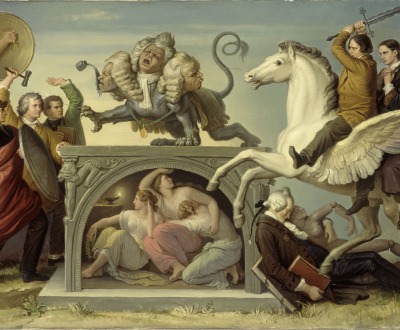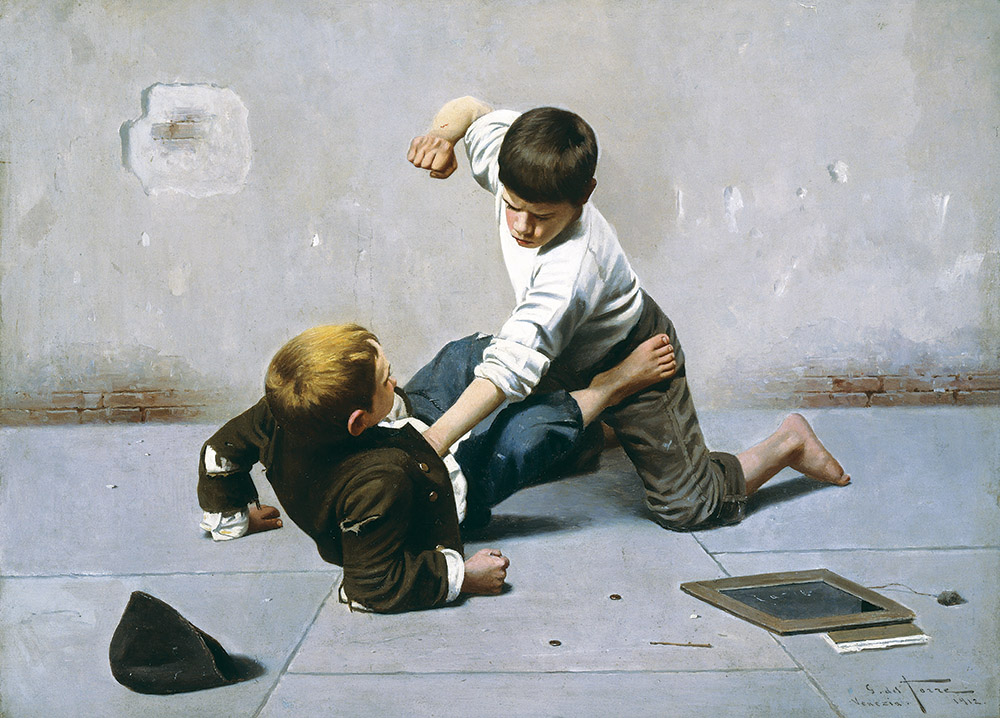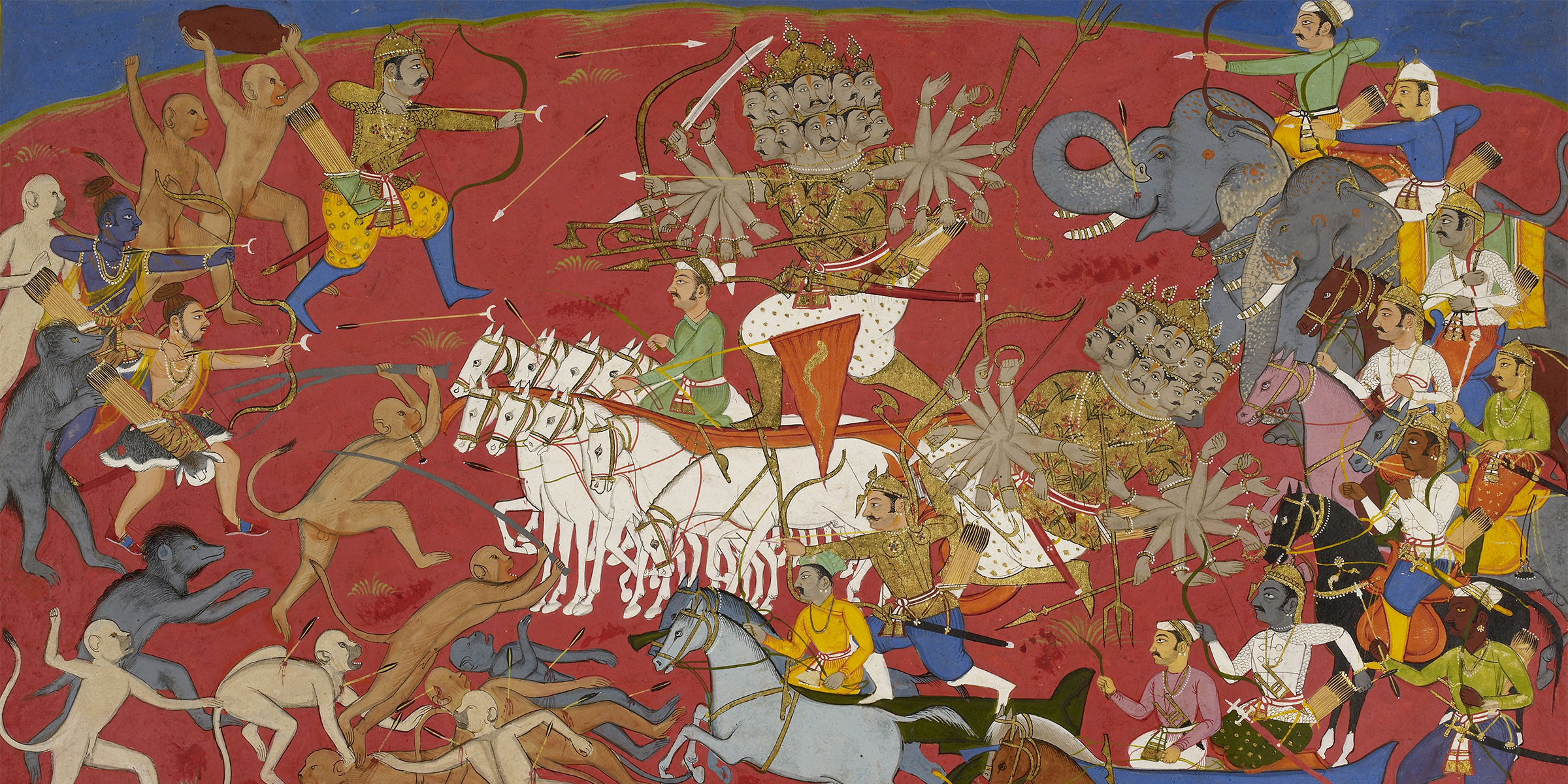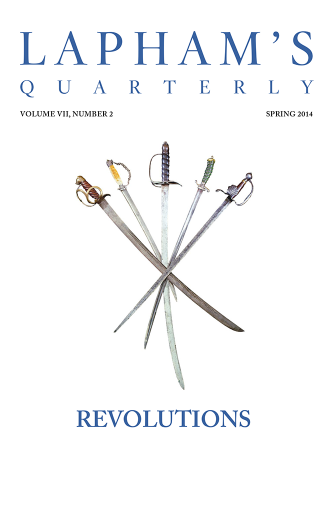Rivalry is the whetstone of talent.
—Roman proverb,
Artists and Scholars Fighting Old-Fashioned Pedantry Under the Protection of Minerva (detail), by Wilhelm von Kaulbach, c. 1851. © bpk Bildagentur / Neue Pinakothek, Bayerische Staatsgemäldesammlungen, Munich / Art Resource, NY.
In 1931 Pearl S. Buck published the novel The Good Earth. Buck was born in the United States but raised in China, the daughter of fervent missionaries from West Virginia. When she was young, though, she grew disenchanted with her family’s calling, which presumed a condescending distance from the heathen masses. Instead, she sympathized with China’s everyday strivers. The Good Earth was about a Chinese farmer named Wang Lung whose thrifty ways and by-his-bootstraps determination protect his family during a time of great upheavals, from drought and famine to political revolution. Buck’s novel arrived at a moment, between the great wars, when Americans had become interested in China’s once-great civilization. The Good Earth was an immediate success, making Buck one of America’s foremost experts on all things Chinese and paving the way for an entire industry for stories about this distant and seemingly exotic land. Her influence spread through magazines, newspapers, Hollywood, the political sphere. She won the Pulitzer Prize and in 1938 became the first American woman to earn the Nobel Prize in Literature. Writers who hoped to be involved in the Asia story sought her approval. She was monolithic.
In the early 2000s, when I was a graduate student casting about for a research project, I became fascinated with Buck’s outsize influence. Decades after her successful run of 1930s and 1940s best sellers, surveys showed that many Americans still relied largely on Buck’s fiction for their understanding of China. But I wanted more friction to this story.
On the way home from the library, I would often stop at a local barbershop to buy the latest mixtapes from New York City crews like the Diplomats and G-Unit, DJs like Whoo Kid, Clue, and Kay Slay. It seemed like every few weeks new artists would emerge from nowhere by dissing whoever was just in front of them. Beefing with someone slightly more famous was how you came to understand the surface of the playing board, who was a king and who was a pawn. Hip-hop has always assumed a measure of antagonism, a mythology built on street-corner battles between rappers, dancers, and DJs. But occasionally these momentary rifts would take on lives of their own, and there has been no sturdier engine of change than full-fledged beefs. In the mid-1980s, the Bronx rapper KRS-One went after MC Shan for the simple reason that Shan had dared to record a song touting his neighborhood in Queens. Years later I was talking to a well-known rapper from around Shan’s way who said that KRS’ ferocity had crushed the entire borough’s esteem. Beef is what propelled artists like KRS and later Jay-Z and 50 Cent to new artistic heights.
Beef is how you won and another lost—and it’s how you understood in the first place that cultural supremacy could be a zero-sum contest. It’s how lesser lights showed everyone they were even worth listening to. My obsession with rappers dissing one another resulted in a strange detour in my scholarship. I became fixated on the possibilities of beef, rivalry, and jealousy not just as the story of the music I loved but as creative spurs. Pettiness and imagined slights could be generative. And it made me wonder: Did Buck have any rivals? Where were the writers who loathed her enough to try to do better?
When we are young, we are taught that great art comes from lofty, ambitious places—the pursuit of truth, beauty, the sublime. Artists struggle with themselves on behalf of the rest of us, in the hope that they might produce something that reflects back a small part of our collective soul, a part that might awe or reshape us. All of this proceeds from long-held beliefs involving muses and divine inspiration, elevating art to some rarefied zone of human exchange. A good book or a painting, we are told, can improve our lives. But rap music taught me a different story about inspirations and motives. When someone undeserving is praised too loudly, this, too, abets creativity.
I eventually found that dissenting voice. In 1931, as Buck was well on her way to fame, riches, and a career as a gatekeeping interlocutor on all things Chinese, a New York–based writer named H.T. Tsiang was readying the self-publication of his first novel, a bizarre epistolary romance titled China Red. Tsiang had worked in the Chinese government in the early days of the republic, only to flee to the United States and pursue the itinerant, often aimless life of a grad student through the 1920s and 1930s. Obviously, everything about his trajectory appealed to me. While Tsiang had come to the United States in the mid-1920s to study politics, at the encouragement of some of his professors at Columbia University, he began publishing poems about the proletarian struggle in America and China. In contrast to Buck’s sentimental hit, China Red was eccentric and sarcastic, critical of overeducated Chinese elites and clueless Americans alike. Instead of having blurbs on the book, he decorated his cover with excerpts from publishers’ rejection letters. There was something cocky and childish about Tsiang. His entire literary career seemed motivated by an interest in being the anti-Buck, and he attacked her (and her characters) with a doggedness I came to find charming. My obsession with Tsiang’s hostility toward Buck eventually resulted in my book on the subject, A Floating Chinaman. In 1935 he boasted to a writer at The New Yorker that he was working on a novel about Chinese laborers that would be “somewhat like The Good Earth, but much better.”
We’re often told that the Beatles and Rolling Stones actually admired one another, that Magic Johnson and Larry Bird were off-court friends. At the end of a fiercely contested battle, there are still handshakes, pleasantries, expressions of mutual admiration, prayer huddles for the only judgment that matters. When younger generations emerge to challenge the bygone revolutions of their forebears, it’s said to be in the service of a grand teleological arc, an earnest desire to do things better. But this has always struck me as an incomplete picture of how culture works. Sometimes brinksmanship tips toward true disdain, and desires to merely show someone up descend into fantasies of destruction. Can dark, trifling feelings produce uplifting art?
I became interested in a version of literary history that is animated not by camaraderie, or by the friendly rivalry of a close-knit cohort, but by antipathy, insecurity, jealousy. After all, writing is a profession like any other. And while literary culture rarely measures worth solely by sales, other metrics of achievement, such as awards and prizes, offer a vaguely reputable kind of side-by-side comparison. The Nobel Prize, for example, has become an annual referendum on the health of our greats. While it’s silly to say that one “loses” the Nobel Prize—the Swedish Academy’s inner workings can be secretive, and in recent years disconcertingly plagued by scandal—there have been writers who have seemed particularly glum about not having been chosen. In the 1920s, Theodore Dreiser, known for his morally ambiguous masterworks of naturalism, felt he had a shot to become the first American winner for literature. Encouraged by his publisher, he began cozying up to European publishers, journalists, and radio broadcasters. But another American contender, Sinclair Lewis, had already been doing this for years; he also had been more outward about his ambitions, describing the Nobel as “his one hope in life.” When Lewis won in 1930, it was seen as a reward for his consistent efforts to court Europe. Some even felt that his novels flattered old-world readers by offering American life as a series of exaggerated caricatures and archetypes.

The Showdown, by Giulio del Torre, 1912. Private Collection / Photo © Christie’s Images / Bridgeman Images.
Dreiser was crestfallen. It was unlikely that another American would win for many years. Yet somehow it was Lewis who bore a grudge. In 1931 they were both at a dinner in New York honoring the Russian novelist Boris Pilnyak. Dreiser congratulated Lewis, who responded with a sneer. Lewis was asked to give an impromptu speech but declined, accusing Dreiser of having plagiarized from The New Russia by Lewis’ wife Dorothy Thompson for Dreiser Looks at Russia. Lewis also called out two unidentified critics in the room who he said had “publicly lamented” his Nobel victory. The night ended with Dreiser slapping Lewis twice.
It stands to reason that artists who possess a sensitivity to human nature would themselves be hypersensitive people. And it makes sense that those with gifts for storytelling and narration are capable of shaping petty jealousy into something noble and epic.
Most rivalries grow out of differences of opinion rather than personality, though the two often become conflated. John Keats, who grew up middle-class, burned with hatred for Lord Byron, whose snobbishness reflected his privileged upbringing. (The feeling was mutual; Byron didn’t care much for “Johnny Keats’ piss-a-bed poetry,” either.) Albert Camus and Jean-Paul Sartre fell out over the question of whether “absolute freedom” and justice could coexist. (A tawdrier possibility is that these questions of agency grew out of a failed Sartre-approved tryst between Camus and Simone de Beauvoir, Sartre’s lover.) In the beginning of their acquaintance Edmund Wilson and Vladimir Nabokov were soul mates, enthralled by each other’s intellect and ego. But their differences, particularly when it came to communism, grew insurmountable. They fell out in 1965, when Wilson savaged his former pal’s translation of Pushkin’s Eugene Onegin, displacing all of his personal and political ire into a comprehensive assault of Nabokov’s quirk-filled approach to form and style.
Even snide, passing disses communicate a sense of aesthetic distinction. Truman Capote once said of Jack Kerouac’s On the Road that it wasn’t writing so much as it was “typewriting.” The “King of Horror,” Stephen King, once complained of James Patterson’s boilerplate best sellers that “every one is the same.”
Rarely are competing visions of literary goodness as clear as in reviews. In 2002, Dale Peck famously called Rick Moody “the worst writer of his generation”—a feud that ended amicably, with Moody throwing a pie in Peck’s face for charity. After Colson Whitehead playfully bashed a short-story collection by Richard Ford in the New York Times, Ford spat on him. (This seemed a more improvised response than the time Ford shot Alice Hoffman’s novel and then mailed her the carcass after she gave his novel The Sportswriter a lukewarm review.)
But the harshest accusation might be to deem your rivals unequal to their onetime promise—that they have somehow failed themselves. In the early 2000s, the rappers Jay-Z and Nas duked it out to see who could claim the crown of “King of New York.” Jay-Z was seen as someone who continually tried on different guises, whereas Nas was the prodigy who had arrived fully formed, as a teenager, with 1994’s Illmatic, an album so admired that it kept him in the good graces of fans even as he struggled for years to return to that preternatural peak. There are few compliments as backhanded as Jay-Z’s withering summation of Nas’ career: “That’s a one-hot-album-every-ten-year average,” as though Nas had let himself down. F. Scott Fitzgerald’s tragic death didn’t soften Ernest Hemingway’s view on his erstwhile friend: “I never had any respect for him ever, except for his lovely, golden, wasted talent.” In 2007, V.S. Naipaul wrote that Derek Walcott had “exhausted the first flush of his talent.” The line came from a long review that also praised the great poet, but it was read as an accusation that Walcott was coasting. Walcott retaliated the following year, at the Calabash Literary Festival, with a poem that begins: “I have been bitten, I must avoid infection / Or else I’ll be as dead as Naipaul’s fiction.”
There was no such thing as an Asian American person until the late 1960s. Around then Yuji Ichioka, a graduate student at the University of California, Berkeley, and his classmates began using the term; before that Americans of Asian descent didn’t have an umbrella term to describe their shared experience. But being able to name themselves, and reject epithets like Oriental or Asiatic, raised complications. What did this new identity mean, and who qualified for inclusion? It was a debate that played out most vociferously in the era’s literature. In 1974 the writers Frank Chin, Jeffery Paul Chan, Lawson Fusao Inada, and Shawn Wong put together Aiiieeeee! An Anthology of Asian American Writers, an earnest attempt at building an archive of authentic, politically self-aware Asian American experiences.
Two years later Maxine Hong Kingston published her first novel, The Woman Warrior, a dazzling and whimsical attempt to reframe identity as improvisatory and inauthentic. It toggled between the epic and the everyday, following a young woman growing up in San Francisco’s Chinatown in the 1960s, making sense of her path through imaginative, radiant retellings of Chinese folktales and family secrets. It was a sly, often ironic work of fiction, yet it became a surprise best seller and ubiquitous presence on college syllabi, in part because it was frequently misread as a work of autobiography and thus an earnest attempt to define the Chinese American experience.
But Kingston’s flippant attitude toward historical truth invoked the ire of a circle of Asian American writers linked to Aiiieeeee! Frank Chin, an idealistic young Chinese American playwright, dismissed her novel as “another in a long line of Chinkie autobiographies by Pocahontas yellows blowing the same old mixed-up East/West soul struggle.” In Chin’s estimation, Kingston had not only commodified her cultural heritage, she had produced a version of it that was fantastical, whimsical, not at all real, full of historical inaccuracies. For Kingston, The Woman Warrior had always been a work of fabulism, or, as she describes it in the novel, “talk-story.” Their back-and-forth went on for years. In 1989, Kingston published Tripmaster Monkey, a novel about Wittman Ah Sing, an idealistic young Chinese American playwright in the 1960s who bore a striking resemblance to Chin. She denied that it was about him. But if Chin had been sending her hate mail all these years, she later joked, it was as though she were sending him back love letters.

The Combat of Rama and Ravana (detail), Indian tapestry, late eighteenth century. © British Library Board / Robana / Art Resource, NY.
There’s always been a sense of fatalism baked into expressions of identity politics—after all, the need to claim a name of one’s own presumes that you’ve been answering to the wrong one for your entire life. The war between Kingston and Chin was a foundational moment in Asian American literature, and it illustrates some basic, competitive dynamics that seem ever-present within circles of creativity that aren’t safely part of the mainstream. What Chin feared was that Kingston’s version of their experience would become popular and immovable. In the view of Chin and the other Aiiieeeee! editors, the Asian American was an outsider, and the truest expressions of this sensibility could exist only outside of the popular. What did it mean that white readers were buying The Woman Warrior?
Variants of this question haunted nonwhite readers throughout the twentieth century. Was something lost in that ascendancy to the mainstream? Black literature, for example, was propelled by a constant reassessment of values and audiences. Richard Wright was critical of how younger writers like Zora Neale Hurston wrote of gender and sexuality, wondering if it all wasn’t a ploy to titillate white readers. James Baldwin attacked his former mentor Wright’s “protest novel” Native Son as a harsh and inhumane portrait of black life—one that feasted on the sympathies of white liberals. And Ralph Ellison was uncomfortable with Baldwin’s homosexuality, as well as the feverish, declarative style of his writings.
In these small segments of the literary marketplace, rivalry and beef came to mean something different. Squabbles over aesthetics or philosophy can usually accommodate different sides. But the literary establishment is overwhelmingly white, and it often anoints but one or two figures to speak on behalf of their marginalized community. To sell your story was to legitimize an identity. In other words, what was at stake when Chin faced off with Kingston, or Baldwin assailed Wright, was who the market would allow them to be: what it meant to be black, or Asian, or a woman, whose version of existence would be the one recorded in history. Often this meant foreclosing possibilities for other writers, other versions of Asian American life that didn’t fit within market-proven tropes like intergenerational struggle or family melodrama. These rivalries called attention to the problem of the market, where notions of authenticity and who would be allowed to embody an entire community’s essence were made solid.
In 1973 the literary critic Harold Bloom published The Anxiety of Influence, his attempt to unlock some of the mysteries that went into literary greatness. He believed that artists were always beholden to those who came before, and that overcoming past traditions demanded a kind of psychological agony. Creation was not a frictionless process. His conclusion, which seems so intuitive nowadays, was that artists must struggle and wrestle with their influences—that they are as much sources of insecurity as they are lodestars.
Bloom’s approach to literary criticism offered a surface engagement of psychological motivations. What might a more contemporary study of creativity look like—a sociology of influence in more outwardly anxious times? How we craft and edit our persona adapts to new forms of communication. Some have argued that the pugilistic bravado of Norman Mailer or Tom Wolfe was inspired by television, which was more amenable to a quick verbal smackdown than something elegant and reasoned. There are perennial discussions about how social media has made us meaner, yet there remains an air of performative backslapping amicability, lest you rile the wrong influencer. Some of the great literary feuds of the past would have been perfect for the social media age, given their withering brevity. Of Lillian Hellman, Mary McCarthy once said, “Everything she writes is a lie, including and and the.” Gertrude Stein told Hemingway that “remarks are not literature.” And the title alone of Clive James’ poem “The Book of My Enemy Has Been Remaindered” captures the egomania of the typical writer, who feels he is the only true aesthete in a field of impostors.
Envy and hatred are apt to blind the eyes and render them unable to behold things as they are.
—Margaret of Valois, 1600From our perspective, the most antiquated moments in the history of literary feuds are the ones when writers devoted entire works to tearing down their rivals. It just seems like a lot of work. In 1915, H.G. Wells published a novel titled Boon that contained a parody of Henry James’ style and perspective. James had once taken an interest in Wells’ career, but the two disagreed about the aims of literature. Wells would later write James, “To you literature like painting is an end, to me literature like architecture is a means, it has a use. Your view was, I felt, altogether too prominent in the world of criticism and I assailed it in lines of harsh antagonism.” He likened James’ style to a hippopotamus trying to pick up a pea. Yet Wells admitted that Boon, which he’d written as an escape from the horrors of World War I, wasn’t a particularly great book. Ultimately, Wells wrote James that he could have handled his disagreement with James’ highfalutin views on the writing life differently. “I had rather be called a journalist than an artist, that is the essence of it, and there was no other antagonist possible than yourself. But since it was printed, I have regretted a hundred times that I did not express our profound and incurable difference and contrast with a better grace.”
Perhaps there’s something cathartic about putting it all out there for posterity. And one begins to recognize what a history of literature would look like if we traced these antagonisms and fleeting character assassinations, these moments of punching up and down. Literary history rarely places James and Wells in conversation as peers, but their spat sheds light on their own shared sense of milieu. Over time I came to realize that Pearl Buck had not been immune to imagining rivals for herself. She never paid attention to Tsiang, who would eventually see himself as a mere “pest.”
Buck’s greatest rival was not a fellow writer but instead the publisher Henry Luce, who had also grown up the son of Chinese missionaries. Luce oversaw a stable of magazines, including Time, Life, and Fortune, that shaped the interests and tastes of millions of Americans. Yet Luce’s and Buck’s views on their onetime home of China drastically differed. He was enamored of the young republic’s political operators, whose visions of transpacific unity brought them in line with American interests. Buck still maintained faith in the Chinese people, not the elites. Luce was the only American whose influence on the subject of China rivaled hers. As her career declined and his publishing empire expanded, he eventually surpassed her. In 1951, Buck published God’s Men, a novel about a megalomaniacal publisher named William Lane. It’s a thinly veiled annihilation of Luce, whose life details Lane shares, and everything he stood for. Her version of Luce settles every score. He becomes a publisher only after failing as a writer; he is driven by profits rather than craft and virtue. He is unlovable, anticharismatic; he has China all wrong. And then she lunges for the ultimate kill shot, cutting to the heart of why so many rivalries seem little more than exercises of macho bluster: she afflicts him with erectile dysfunction.
